Petroleum in the United States
| This article is part of a series on the |
| Economy of the United States |
|---|
 |

in barrels of oil a day (average for the month)



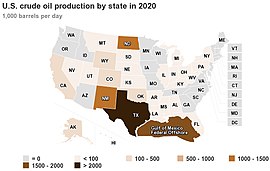
Petroleum has been a major industry in the United States since the 1859 Pennsylvania oil rush around Titusville, Pennsylvania. Commonly characterized as "Big Oil", the industry includes exploration, production, refining, transportation, and marketing of oil and natural gas products.[1] The leading crude oil-producing areas in the United States in 2023 were Texas, followed by the offshore federal zone of the Gulf of Mexico, North Dakota and New Mexico.[2]
The United States became the largest producer of crude oil of any nation in history in 2023.[3] Natural gas production reached record highs.[4] Employment in oil and gas extraction peaked at 267,000 in March 1982, and totaled 199,500 in March 2024.[5]
Industry structure
The United States oil industry is made up of thousands of companies, engaged in exploration and production, transportation, refining, distribution, and marketing of oil. The industry is often informally divided into "upstream" (exploration and production), "midstream" (transportation and refining), and "downstream" (distribution and marketing). The industry sector involved in oil exploration and production is for all practical purposes identical with the sector exploring and producing natural gas, but oil and natural gas have different midstream and downstream sectors (see: Natural gas in the United States).
Majors
The term major oil company has no formal definition, but usually refers to a large vertically integrated company, with operations in all or most of the industry phases, from exploration to marketing. Many majors have international operations.
The largest of the majors are sometimes called
Independents
An independent is a company which has all or almost all of its operations in a limited segment of the industry, such as exploration and production, refining, or marketing. Although most independents are small compared to the majors, there are some very large companies which are not vertically integrated, and so are classed as independents.
Service companies
Service companies contract to oil companies to perform specialized services. Examples are companies that do well logging (Schlumberger), seismic surveys (WesternGeco, CGG (company)), drilling (Nabors Industries, Helmerich & Payne), or well completion (Baker Hughes, Halliburton). There are innumerable small oil (craft oil) producers whose aggregate crude oil production exceeds the aggregate production of major crude oil companies.[6]
| Rank | Company | Million Bbl/Year |
|---|---|---|
| 1 | BP | 237.0 |
| 2 | Chevron | 177.0 |
| 3 | ConocoPhillips | 153.0 |
| 4 | ExxonMobil | 112.0 |
| 5 | Occidental Petroleum | 99.0 |
| 6 | Shell | 71.0 |
| 7 | Anadarko Petroleum | 63.0 |
| 8 | Apache Corporation
|
34.8 |
| 9 | XTO Energy | 31.7 |
| 10 | Amerada Hess
|
26.0 |
| Annual owned production, 2009. Source:[7] | ||
In 2009, the production owned by the top ten companies was 52% of total US oil production.[7]
Exploration
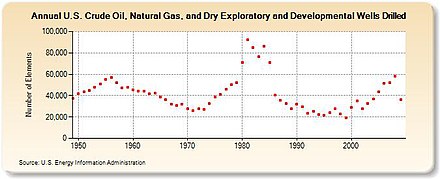
Exploratory drilling, seismic and other remote sensing techniques are used to explore for and find new hydrocarbon resources. Satellites, remote-sensing devices, and 3-D/4-D seismic technologies are some of these technologies. Smaller “slimhole” drilling rigs are able to drill smaller exploratory wells to reduce the size of the impacted area.[8]
Each year, tens of thousands of wells are drilled in search of oil and gas in the U.S. In 2009, 36,243 wells were drilled.


Production
Top oil fields in the U.S.
| Rank | Field | State | Discovery Year | Million Bbl/Day |
|---|---|---|---|---|
| 1 | Permian | Texas/New Mexico | 1920 | 4.2 |
| 2 | Eagle Ford Shale
|
Texas | 2008 | 1.34 |
| 3 | Bakken | North Dakota/Montana | 1951 | 1.33 |
| 4 | Prudhoe Bay Oil Field | Alaska | 1967 | .791 |
| 5 | Wattenberg Gas Field | Colorado | 1970 | .473 |
| 6 | Shenzi | Federal Gulf of Mexico | 2002 | .353 |
| 7 | Kuparuk River oil field | Alaska | 1969 | .295 |
| 8 | Midway-Sunset Oil Field | California | 1901 | .288 |
| 9 | Atlantis Oil Field | Federal Gulf of Mexico | 1998 | .273 |
| 10 | Sugarkane | Texas | 2009 | .258 |
| Annual production 2013. Source:[9] | ||||
Associated gas
Most modern oil fields are developed with plans to utilize both the oil and the
Produced water
When extracting oil and gas from oil sands and shale oil, water that was present is extracted as well, which is called “produced water”. In 2017, an estimated 160 billion gallons of produced water was generated during U.S. shale oil and gas producing operations. Ongoing research seeks to identify safe ways to reuse produced water.[12] The water is usually highly saline, and must be disposed of by injecting it into EPA-permitted Class II water disposal wells.
Some produced water contains sufficient lithium, iodine, etc. to be recovered as a by-product.[13]
Crude oil transportation and storage
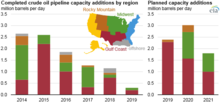
The product extracted at the wellhead, usually a mixture of oil/condensate, gas, and water, goes through equipment on the lease to separate the three components. The oil and produced water are in most cases stored in separate tanks at the site, and periodically removed by truck. Over the decade 2005–2014, the volume of oil carried to the refinery by tanker ship has decreased. The oil volumes delivered to US refineries by all other modes has increased. Crude oil and petroleum products are transported mainly by pipelines, rail, or water via tanker ships. The U.S. has more than 3 million miles of pipeline dedicated to the transportation of natural gas.[14]
Pipeline
Most crude oil shipped long distances in the US goes by
Water
Petroleum can be transported cheaply for long distances by oceangoing oil tankers. Tankers supplied 31 percent of the oil arriving at US refineries in 2014, down from 48 percent in 2005; the decline reflects decreased oil imports since 2005.
For shorter-distance water transport, oil is shipped by barge, which accounted for 5.7 percent of oil arriving at refineries in 2014, up from 2.9 percent in 2005.
Truck
Most oil is initially carried off the site by tanker truck. The truck may take the oil directly to a nearby refinery. In 2014, 2.6 percent of oil arrived at refineries by truck, up from 2.6 percent in 2005. If the refinery is not close, the tanker truck will take the crude oil to a pipeline, barge, or railroad for long-distance transport.
Railroad
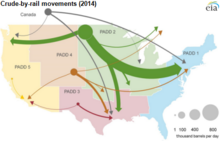
Before the common availability of long-distance pipelines, most crude oil was shipped by rail. It is for this historical reason that in Texas, oil and gas production came to be regulated by the
Since 2012, oil shipped by rail from the Bakken fields in North Dakota has progressively replaced overseas (non-Canadian) imported oil used by East Coast US refineries. In February 2015, railroads supplied 52 percent of all crude oil delivered to US refineries on the East Coast.[16]
Rail transportation also resulted in the July 6, 2013
Storage

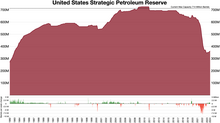
Crude oil is stored in oil terminals above ground, natural gas storage is primarily done underground. Private companies store oil and participate in the oil-storage trade to try and get the best deal on their oil. Governments also store oil in Strategic Petroleum Reserves to cope with Geopolitical /economic shocks.[17]
Refining

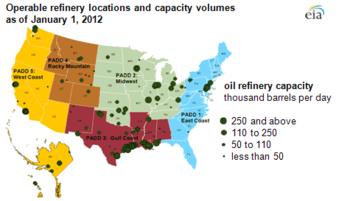
The United States petroleum refining industry, the world's largest, is most heavily concentrated along the Gulf Coast of Texas and Louisiana. In 2012, US refiners produced 18.5 million barrels per day of refined petroleum products.[18] Of this amount, 15 percent was exported.[19] As of 2012 the US was the world's second largest net exporter of refined petroleum products.[20]
Petroleum product distribution and marketing
Refined petroleum products destined for retail consumption is transferred to bulk terminals by pipeline, barge, or rail. From the bulk terminal, the product is usually trucked to the retail outlets.
As of February 2014, there were 153,000 service stations selling motor fuel in the US, including garages, truck stops, convenience stores, and marinas. Although many stations carry the brands of major integrated oil companies, only 2% of US stations are owned by major oil companies; most stations labeled with major brands are operated under franchise agreements. A total of 58% of the service stations are single-store operations run by an individual or family.[21][22]
Price

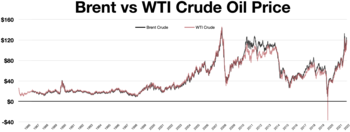
Except for one, every US recession since
In 2008, oil prices rose briefly, to as high as $145 per barrel,[25] and U.S. gasoline prices jumped from $1.37 to $2.37 per gallon in 2005,[26] causing a search for alternate sources, and by 2012, less than half the US oil consumption was imported. However, as of January 2015, the price of oil has decreased to around $50 per barrel.[27] As of September 2021, the price per barrel of crude oil was $69.06.[28]
Consumption and production
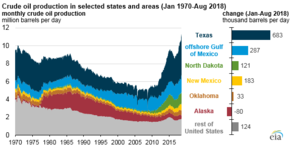
In the twentieth century, oil production became of more value, as the US industrialized and developed commercial transportation, such as railroads and motor vehicles. Furthermore, oil consumption also increased because of electricity. After electricity, oil became more important in commercial, manufacturing, and residential sectors such as heating and cooking. Therefore, during this period, the growth of oil consumption indicates that the US was becoming dependent on oil and that it helped the domestic oil industry to grow. However, U.S. oil domestic production could not cover the growing demand in the nation's market, which allowed the U.S. to look for a new supply internationally.[29]
The nation's consumption of oil increased 53% between 1915 and 1919, followed by another increase of 27% in 1920. The first shock of the transportation era occurred in 1920 and lasted for about a year. The shortage of oil devastated the entire West Coast with hour-long lines for gasoline. Also, in many places, fuel was not available for at least a week. Finally, big production from Texas, California, and Oklahoma took the shortage of oil away, causing oil prices to fall 40% between 1920 and 1926. During the Great Depression, both growing supply and falling demand caused the price of oil to decrease to about 66% between 1926 and 1931.[29]
Toward the end of World War II, the automotive era settled rapidly, and the nation's demand of oil increased 12% between 1945 and 1947 while motor vehicle registrations did so by 22%. Around 1948, demand of oil exceeded the supply of oil, allowing the U.S. to start importing oil. Therefore, the nation quickly became a major importer of oil, rather than being the major exporter for it.[29]
In 1952, due to a
After the
In 2010, 70.5% of petroleum consumption in the U.S. was for transportation. Approximately 2/3 of transportation consumption was gasoline.[30] Today, the U.S. is still dependent on oil, as oil plays an important role socially, economically, and politically.
In May 2019, the United States produced a record 12.5 million barrels of oil per day and it is expected to reach to a record 13.4 million barrels per day by the end of 2019.[31]
In 2020, U.S. refineries produced about 18.375 million barrels of petroleum products per day. Crude oil making up 11.283 million barrels, natural gas liquids making up 5.175 million barrels, and other petroleum products making up the rest.[32]
Policy
While the time before


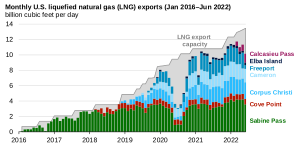
Near the end of 2015 President Barack Obama signed a spending bill lifting a four decade ban on exports of crude oil.[36]
On March 24, 2017, the Trump administration issued a presidential permit to allow construction of the Keystone XL pipeline. In June 2017, President Donald Trump announced his intention to withdraw the U.S. from the Paris Agreement. Although under Article 28 of the Paris Agreement the U.S. could not officially withdraw from until 2020. In his announcement the President stated “as of today, the United States will cease all implementation of the Paris Agreement”.[37] On August 17, 2020, the Trump administration opened the Arctic National Wildlife Refuge to oil exploitation.[38]
In 2021, President Joe Biden rejoined the Paris Agreement and closed the Arctic National Wildlife Refuge to oil exploitation. On January 20, 2021, the Biden administration revoked the permits for construction of the Keystone XL pipeline.[39]
During the 2020 Russia–Saudi Arabia oil price war, the Texas Railroad Commission again discussed pro-rationing to keep oil prices at a level suitable for US producers. Texas ordinarily produces 5.3 million barrels per day, and the US maximum production is 13 million.[40]
History


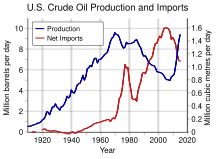
Although some oil was produced commercially before 1859 as a byproduct from salt brine wells, the American oil industry started on a major scale with the discovery of oil at the Drake Well in western Pennsylvania in 1859.
US crude oil production initially peaked in 1970 at 9.64 million barrels (1,533,000 m3) per day. 2018 production was 10.99 million barrels (1,747,000 m3) per day of crude oil (not including natural gas liquids).[41]
- Pennsylvanian oil rush
- Office of Naval Petroleum and Oil Shale Reserves
- Petroleum Administration for Defense District
- Texas wildcatters
- Oil Capital of the World
Statistics
The Energy Information Administration of the United States Department of Energy publishes extensive statistics on the production, importation, and uses of petroleum in the United States.[42]
In 1913, the United States was extracting 65 percent of the world's petroleum.[citation needed]. In 1989, the United States contained 5 percent of the world's oil reserves.[citation needed] In 2022, New Mexico produced more oil than Mexico.[43]
Politics
In 2007, state severance taxes amounted to $10.7 billion, mostly from oil, gas, and coal. States also received 50 percent of federal onshore oil and gas lease revenues within their borders, and 27 percent of federal offshore oil and gas revenues adjacent to their shorelines; the state share of federal revenues totalled $2.0 billion in 2007.[44]
Environmental issues
Organizations
- American Association of Petroleum Geologists
- American Petroleum Institute
- Council of Petroleum Accountants Societies
- Nevada Petroleum Society
See also
- Energy conservation in the United States
- Energy in the United States
- Energy policy of the United States
- History of the petroleum industry in the United States
- Natural gas in the United States
- Offshore oil and gas in the United States
- The Petroleum Dictionary (book)
- Shale gas in the United States
By State:
References
- ^ American Petroleum Institute, [1], accessed 20 February 2010.
- ^ "Crude Oil Production". www.eia.gov. Retrieved April 29, 2021.
- ^ Egan, Matt (December 19, 2023). "The United States is producing more oil than any country in history". CNN.
- ^ Kemp, John (March 3, 2024). "Record US oil and gas production keeps prices under pressure". Reuters.
- ^ "All Employees, Oil and Gas Extraction". Bureau of Labor Statistics. via Federal Reserve Economic Data. April 5, 2024.
- ^ "Craft Oil: The Lesser Known Side of America's Energy Industry". March 14, 2018. Retrieved June 22, 2018.
- ^ a b US Energy Information Administration, Top 100 Operators, 2009, accessed 2 August 2015.
- ^ "Oil and the environment - U.S. Energy Information Administration (EIA)". www.eia.gov. Retrieved December 10, 2021.
- ^ US Energy Information Administration, Top 100 U.S. oil and gas fields, Mar. 2015
- ^ "Global Gas Flaring Reduction Partnership". World Bank. Retrieved December 31, 2019.
- U.S. Energy Information Administration. Retrieved December 31, 2019.
- S2CID 212995630.
- ^ "Petrolithium: Extracting Minerals From Petroleum Brine". Retrieved June 22, 2018.
- ^ "General Pipeline FAQs | PHMSA". www.phmsa.dot.gov. Retrieved December 10, 2021.
- ^ Christopher E. Smith, "Oil pipelines lead way in strong 2014," Oil & Gas Jolurnal, 7 September 2015, p.110-128.
- ^ Crude by rail accounts for more than half of East Coast refinery supply in February, Today in Energy, US EIA, 5 May 2015.
- ^ "Research Guides: Oil and Gas Industry: A Research Guide: Storage".
- ^ OPEC, “World production of petroleum products by country.” Archived 2014-04-23 at the Wayback Machine Table 3.14, accessed 7 Mar. 2014.
- ^ OPEC, “World exports of petroleum products by country,” Archived 2014-04-23 at the Wayback Machine Table 3.20, accessed 7 Mar 2014.
- ^ OPEC, “World imports of petroleum products by country Archived 2014-04-23 at the Wayback Machine, (Figure from Table 3.20, minus figure from Table 3.24) accessed 7 Mar. 2014.
- ^ American Petroleum Institute, Service station FAQs, accessed 2 August 2015.
- ^ Painter, David S. Oil and the American Century. Baltimore: Johns Hopkins UP, 1986. June 2012. Web. 11 May 2017.
- ^ a b Hamilton, James D. (April 1983). "Oil and the Macroeconomy since World War II" (PDF). The Journal of Political Economy. The University of Chicago Press. Retrieved June 22, 2014.
- S2CID 2875906. Retrieved June 22, 2014.
- ^ "History and Analysis -Crude Oil Prices". Wtrg.com. Archived from the original on January 2, 2008. Retrieved October 14, 2017.
- ^ "GAO-05-525SP, Motor Fuels: Understanding the Factors That Influence the Retail Price of Gasoline". Gao.gov. May 2, 2005. Retrieved October 14, 2017.
- ^
Moore, Stephen (October 1, 2011). "How North Dakota Became Saudi Arabia: Harold Hamm, discoverer of the Bakken fields of the northern Great Plains, on America's oil future and why OPEC's days are numbered". Wall Street Journal. Retrieved October 1, 2011.
When OPEC was at its peak in the 1990s, the U.S. imported about two-thirds of its oil. Now we import less than half of it, and about 40% of what we do import comes from Mexico and Canada.
- ^ "U.S. Crude Oil First Purchase Price (Dollars per Barrel)". www.eia.gov. Retrieved December 10, 2021.
- ^ a b c d e Hamilton, James. "Historical Oil Shocks" (PDF). Econweb. University of California, San Diego. Retrieved June 22, 2014.
- ^ "Petroleum Flow 2010" (PDF). Eia.gov. Retrieved October 14, 2017.
- ^ "America's oil boom will break more records this year".
- ^ "FREQUENTLY ASKED QUESTIONS (FAQS) - U.S. Energy Information Administration (EIA)". www.eia.gov. Retrieved January 17, 2024.
- ^ a b Van Doren, Peter. "A Brief History of Energy Regulations" (PDF). downsizinggovernment. CATO Institute. Retrieved June 22, 2014.
- ^ Carter, Jimmy (January 23, 1980). "Third State of the Union Address". Jimmy Carter Presidential Library. Retrieved July 27, 2008.
{{cite journal}}: Cite journal requires|journal=(help) - ISBN 978-0-312-16395-2. Retrieved July 27, 2008.
- ^ Rich, Gillian (December 18, 2015). "Oil Export Ban Lifted As Obama Signs Spending Bill". Investor's Business Daily. Retrieved June 30, 2019.
- ^ "President Trump Announces Withdrawal From Paris Agreement | Sabin Center for Climate Change Law". climate.law.columbia.edu. Retrieved December 10, 2021.
- ^ "Keystone XL Pipeline political timeline". Ballotpedia. Retrieved December 10, 2021.
- ^ "Timeline: Oil Dependence and U.S. Foreign Policy". Council on Foreign Relations. Retrieved December 10, 2021.
- ^ Salzman, Avi (April 3, 2020). "How an Unprecedented Global Oil Deal Could Happen Soon, According to the Texas Commissioner at the Center of It". www.barrons.com. Archived from the original on April 5, 2020.
A large portion of the leadership of oil companies in Texas are in favor of being a part of an international deal.
- ^ "U.S. Field Production of Crude Oil (Thousand Barrels per Day)". www.eia.gov. Retrieved September 22, 2019.
- ^ "Petroleum and Other Liquids". Energy Information Administration, United States Department of Energy. Retrieved September 8, 2011.
- ^ Myles McCormick (January 31, 2023). "US jobs boom in the 'busiest spot in the busiest oilfield'". Financial Times. Retrieved February 1, 2023.
The state of New Mexico's crude production last year eclipsed output from the entire country of Mexico.
- ^ Judy Zelio and Lisa Houlihan, State Energy Revenues Update, National Conference of State Legislatures, June 2008.
- ^ "Rigs-to-Reefs | Bureau of Safety and Environmental Enforcement". www.bsee.gov. Retrieved December 10, 2021.
